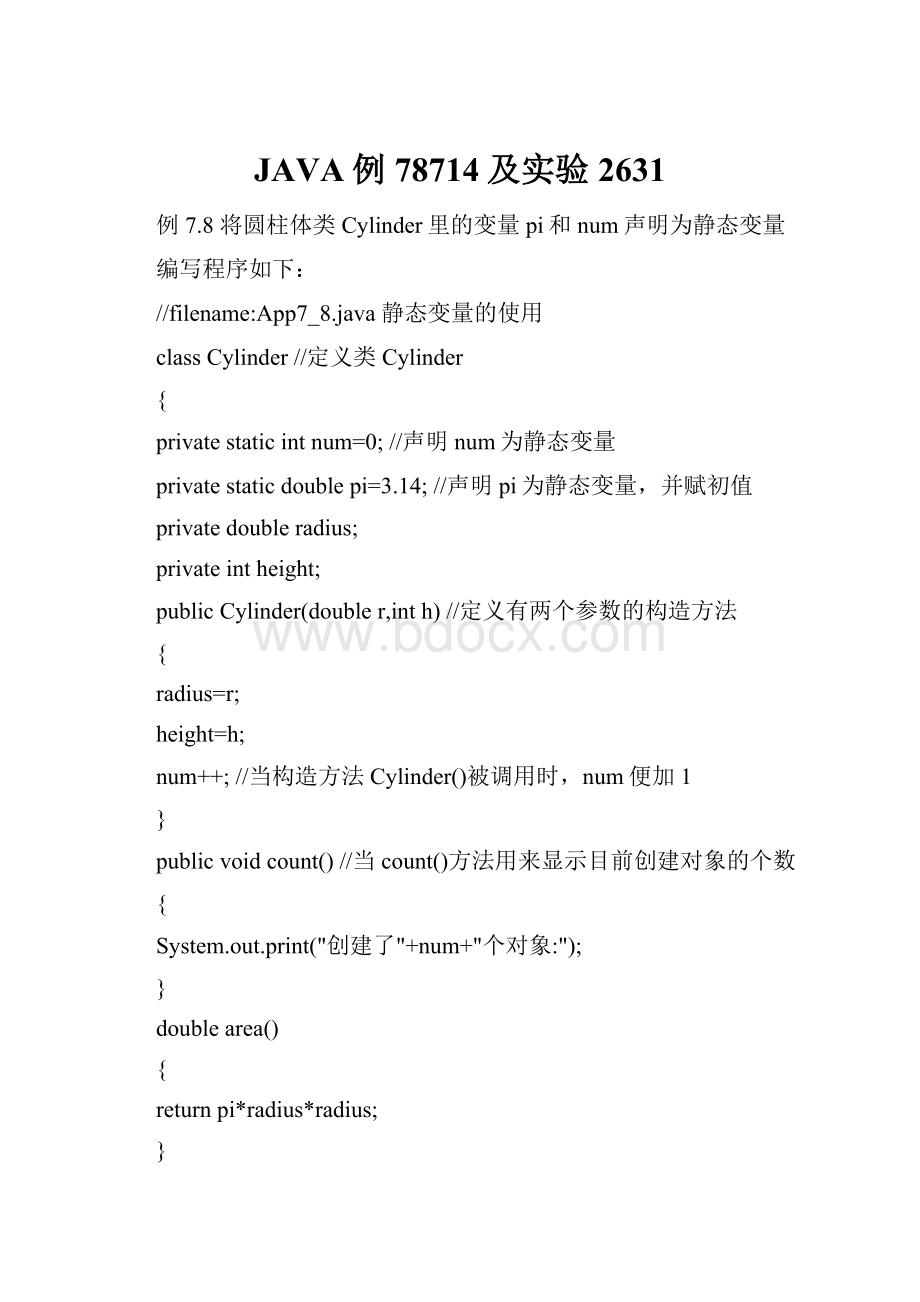JAVA例78714及实验2631.docx
《JAVA例78714及实验2631.docx》由会员分享,可在线阅读,更多相关《JAVA例78714及实验2631.docx(22页珍藏版)》请在冰豆网上搜索。

JAVA例78714及实验2631
例7.8将圆柱体类Cylinder里的变量pi和num声明为静态变量
编写程序如下:
//filename:
App7_8.java静态变量的使用
classCylinder//定义类Cylinder
{
privatestaticintnum=0;//声明num为静态变量
privatestaticdoublepi=3.14;//声明pi为静态变量,并赋初值
privatedoubleradius;
privateintheight;
publicCylinder(doubler,inth)//定义有两个参数的构造方法
{
radius=r;
height=h;
num++;//当构造方法Cylinder()被调用时,num便加1
}
publicvoidcount()//当count()方法用来显示目前创建对象的个数
{
System.out.print("创建了"+num+"个对象:
");
}
doublearea()
{
returnpi*radius*radius;
}
doublevolume()
{
returnarea()*height;
}
}
publicclassApp7_8//主类
{
publicstaticvoidmain(String[]args)
{
Cylindervolu1=newCylinder(2.5,5);
volu1.count();
System.out.println("圆柱1的体积="+volu1.volume());
Cylindervolu2=newCylinder(1.0,2);
volu2.count();
System.out.println("圆柱2的体积="+volu2.volume());
}
}
运行结果如下:
例7.9利用圆柱体类Cylinder来介绍静态方法的使用
程序编写如下:
//filename:
App7_9.java静态方法的使用
classCylinder//定义类Cylinder
{
privatestaticintnum=0;
privatestaticdoublepi=3.14;
privatedoubleradius;
privateintheight;
publicCylinder(doubler,inth)
{
radius=r;
height=h;
num++;//当构造方法Cylinder()被调用时,num便加1
}
publicstaticvoidcount()//当count()为静态方法
{
System.out.println("创建了"+num+"个对象");
}
doublearea()
{
returnpi*radius*radius;
}
doublevolume()
{
returnarea()*height;
}
}
publicclassApp7_9//主类
{
publicstaticvoidmain(String[]args)
{
Cylinder.count();
Cylindervolu1=newCylinder(2.5,3);
volu1.count();
System.out.println("圆柱1的体积="+volu1.volume());
Cylindervolu2=newCylinder(1.0,2);
Cylinder.count();
System.out.println("圆柱2的体积="+volu2.volume());
}
}
运行结果如下:
例7.10创建圆柱体类Cylinder,并对该类生成的对象进行赋值运算。
//filenameApp7_10.java
classCylinder//定义类Cylinder
{
privatestaticdoublepi=3.14;
privatedoubleradius;
privateintheight;
publicCylinder(doubler,inth)
{
radius=r;
height=h;
}
publicvoidsetCylinder(doubler,inth)
{
radius=r;
height=h;
}
doublevolume()
{
returnpi*radius*radius*height;
}
}
publicclassApp7_10//主类
{
publicstaticvoidmain(String[]args)
{
Cylindervolu1,volu2;//声明volu1,volu2两个引用型变量
volu1=newCylinder(2.5,5);//创建对象,并将volu1指向它
System.out.println("圆柱1的体积="+volu1.volume());
volu2=volu1;//将volu1赋值给volu2,volu2也指向了该对象
volu2.setCylinder(1.0,2);//重新设置圆柱的底半径和高
System.out.println("圆柱2的体积="+volu1.volume());
}
}
程序运行结果及其分析:
在该例的主方法main()中,声明了volu1,volu2两个Cylinder类型的变量,但只创建了一个对象volu1。
对于volu2,使用了赋值语句volu2=volu1,将两个不同名的引用变量指向同一个对象。
故通过任一个引用变量对对象进行修改,另一个引用变量所指向的对象内容也会随之更改。
例7.11以圆柱体类Cylinder的对象为参数进行方法调用,并说明对象的比较。
//filenameApp7_11.java
classCylinder//定义类Cylinder
{
privatestaticdoublepi=3.14;
privatedoubleradius;
privateintheight;
publicCylinder(doubler,inth)
{
radius=r;
height=h;
}
publicvoidcompare(Cylindervolu)//以对象作为方法的参数
{
if(this==volu)//判断this与volu是否指向同一对象
System.out.println("这两个对象相等");
else
System.out.println("这两个对象不相等");
}
}
publicclassApp7_11//主类
{
publicstaticvoidmain(String[]args)
{
Cylindervolu1=newCylinder(1.0,2);
Cylindervolu2=newCylinder(1.0,2);
Cylindervolu3=volu1;
pare(volu2);//调用compare(),比较volu1与volu2是否相等
pare(volu3);//调用compare(),比较volu1与volu3是否相等
}
}
程序运行结果及其分析:
在该例中,Cylinder类的compare()方法接收的参数是对象,并用if(this==volu)语句判断两个引用变量是否相等。
在主方法main()中,声明了三个引用变量volu1,volu2和volu3,并且用相同的实参创建了两个对象volu1和volu2。
然而volu1与volu2是两个彼此独立的对象,是两个占据不同内存空间地址的不同对象。
引用变量volu1与volu2的值分别是这两个对象在内存中的首地址,显然它们是不相等的;而volu1与volu3是指向同一个对象的两个变量,它们的值是同一对象在内存中的首地址,故两者相等。
例7.12创建个人类Person,在该类中定义一个以对象作为返回值的方法compare()。
//filenameApp7_12.java
classPerson//定义类Person
{
privateStringname;
privateintage;
publicPerson(Stringname,intage)
{
this.name=name;
this.age=age;
}
publicPersoncompare(Personp)//返回值的类型为对象
{
if(this.age>p.age)
returnthis;//返回值调用该方法的对象
else
returnp;//返回参数对象
}
}
publicclassApp7_12
{
publicstaticvoidmain(String[]args)
{
Personper1=newPerson("张三",20);
Personper2=newPerson("李四",21);
Personper3;
per3=pare(per2);
if(per3==per1)
System.out.println("张三年龄大");
else
System.out.println("李四年龄大");
}
}
程序运行结果及其分析:
该程序是通过比较两个对象的成员变量age的大小,来返回age的值较大的对象。
例7.13对象数组的应用。
以个人类Person为类型,创建数组。
//filenameApp7_13.java
classPerson
{
privateStringname;
privateintage;
publicPerson(Stringname,intage)
{
this.name=name;
this.age=age;
}
publicvoidshow()
{
System.out.println("姓名:
"+name+"年龄:
"+age);
}
}
publicclassApp7_13
{
publicstaticvoidmain(String[]args)
{
Person[]per;//声明类类型的数据
per=newPerson[3];//用new运算符为数组分配内存空间
per[0]=newPerson("张三",20);//用new运算符创建新对象,并分配给数组元素
per[1]=newPerson("李四",21);
per[2]=newPerson("王二",19);
per[2].show();//利用对象per[2]调用show()方法
per[0].show();
}
}
程序运行结果及其分析:
在主方法main()中,定义了包含3个元素的数组per,其类型为Person类类型,即数组元素是Person类型的变量,所以程序中分别用数组元素指向新建对象的内存地址。
用不同的对象调用相应的show()方法,则显示出相应对象的成员数据。
例7.14以对象组作为参数传递给方法,返回对象数组中最小的成员变量。
//filenameApp7_14.java
classPerson
{
privateStringname;
privateintage;
publicPerson(Stringname,intage)
{
this.name=name;
this.age=age;
}
publicstaticintminAge(Person[]p)//以对象数组作为参数传递给方法
{
intmin=Integer.MAX_VALUE;
for(inti=0;iif(p[i].agemin=p[i].age;//将对象数组中成员变量age的最小值存入变量min中
returnmin;//返回对象数组中最小的成员变量的值
}
}
publicclassApp7_14
{
publicstaticvoidmain(String[]args)
{
Person[]per=newPerson[3];
per[0]=newPerson("张三",20);
per[1]=newPerson("李四",21);
per[2]=newPerson("王二",19);
System.out.println("最小的年龄为:
"+Person.minAge(per));
}
}
程序运行结果及其分析:
实验26类的私有成员与公共成员
实验要求:
编写一个Java程序,在程序中定义一个Person类,其中age属性是一个私有属性,并且范围在5~20之间
classPerson
{
Stringname;
privateintage;
publicbooleansetAge(intnewAge)
{
if(5<=newAge&&newAge<=20)
{
age=newAge;
return(true);
}
else
return(false);
}
publicintgetAge()
{
return(age);
}
}
publicclassApp
{
publicstaticvoidmain(String[]args)
{
Persons1=newPerson();
s1.name="张三";
if(s1.setAge(25))
System.out.println("姓名:
"+s1.name+",年龄:
"+s1.getAge());
else
System.out.println("年龄错误");
}
}
运行结果如下:
实验27类的构造方法1
实验要求:
编写一个Java程序,在程序中定义Student类,Student类有三个构造方法,分别对不同的属性进行初始化
编写程序如下
classStudent//定义类Student.
{
Stringname;
intage;
publicStudent()//定义无参的构造方法。
{
System.out.println("Student()构造方法被调用");
}
publicStudent(Stringc)//定义有一个参数的构造方法。
{
name=c;
System.out.println("Student(StringnewName)构造方法被调用");
}
publicStudent(Stringa,intb)//定义有两个参数的构造方法。
{
name=a;
age=b;
System.out.println("Student(StringnewName,intnewAge)构造方法被调用");
}
publicstaticvoidmain(String[]args)
{
Studentvolu1=newStudent();//创建Student类的一个对象,不传入参数
Studentvolu2=newStudent("张三");
//创建Student类的一个对象,传入一个参数:
”张三”
Studentvolu3=newStudent("张三",15);
//创建Student类的一个对象,传入两个参数:
”张三”、15
}
}
运行结果如下
程序分析如下:
程序中的Student类有三个构造方法,分别对不同的属性进行初始化。
实验28类的构造方法2
实验要求:
编写一个Java程序,在程序中定义一个Employee类,Employee类有四个构造方法,分别对不同的属性进行初始化,有一个setAge()方法能设置age属性值,有一个getAge()方法能返回age属性值
程序编写如下:
classEmployee
{
privateStringname;
privateintage;
privatedoublesalary;
publicEmployee(StringnewName,intnewAge,doublenewSalary)
{
this(newAge,newSalary);
System.out.println("三个参数的构造方法被调用");
name=newName;
}
publicEmployee(intnewAge,doublenewSalary)
{
this(newSalary);
System.out.println("两个参数的构造方法被调用");
age=newAge;
}
publicEmployee(doublenewSalary)
{
this();
System.out.println("一个参数的构造方法被调用");
salary=newSalary;
}
publicEmployee()
{
System.out.println("没有参数的构造方法被调用");
}
voidsetAge(intnewAge)
{
intage=0;
this.age=newAge;
}
intgetAge()
{
returnage;
}
publicstaticvoidmain(String[]args)
{
Employees1=newEmployee("李四",30,8000);
s1.setAge(31);
System.out.println("年龄是"+s1.getAge());
}
}
运行结果如下:
实验29编写一个java程序,在程序中定义一个MyPlus类,MyPlus类有三个plus()方法,分别对不同的参数进行求和。
//MyPlus.java
classMyPlus
{
publicintplus(inta,intb)
{
ints;
s=a+b;
returns;
}
publicintplus(inta,intb,intc)
{
ints;
s=plus(a,b)+c;
returns;
}
publicintplus(inta,intb,intc,intd)
{
ints;
s=plus(a,b,c)+d;
returns;
}
publicstaticvoidmain(String[]args)
{
MyPlusp=newMyPlus();
System.out.println("1+2="+p.plus(1,2));
System.out.println("1+2+3="+p.plus(1,2,3));
System.out.println("1+2+3+4="+p.plus(1,2,3,4));
}
}
程序运行结果:
实验30编写一个java程序,在程序中定义一个Ca类,Ca类有静态成员和非静态成员,再定义一个Cb类,在Cb类中创建Ca类的对象。
//Ca.java
classCa
{
inta;
staticintb;
publicstaticvoidm1()
{
inta=10;
intb=10;
}
publicvoidm2()
{
a=5;
b=5;
}
publicvoidm3()
{
m1();
m2();
}
}
classCb
{
publicstaticvoidmain(String[]args)
{
Cas1=newCa();
Cas2=newCa();
Ca.b=5;
s1.b=6;
s2.b=7;
System.out.println("Ca.b="+Ca.b);
System.out.println("s1.b="+s1.b);
System.out.println("s2.b="+s2.b);
}
}
实验31编写一个java程序,在程序中定义一个StudentA类,生成StudentA类的两个对象,分别对这些对象进行赋值,再进行比较。
//StudentA.java
publicclassStudentA
{
StringstrName;
publicstaticvoidmain(String[]args)
{
StudentAa=newStudentA();
a.setName("张三");
StudentAb=a;
b.setName("李四");
StudentAc=newStudentA();
c.setName("王五");
System.out.println("a的名字是"+a.getName());
System.out.println("b的名字是"+b.getName());
System.out.println("c的名字是"+c.getName());
if(a==b)
System.out.println("a与b相等");
else
System.out.println("a与b不相等");
if(a==c)
System.out.println("a与c相等");
else
System.out.println("a与c不相等");
}
publicvoidsetName(Stringname)
{
this.strName=name;
}
publicStringgetName()
{
returnstrName;
}
}